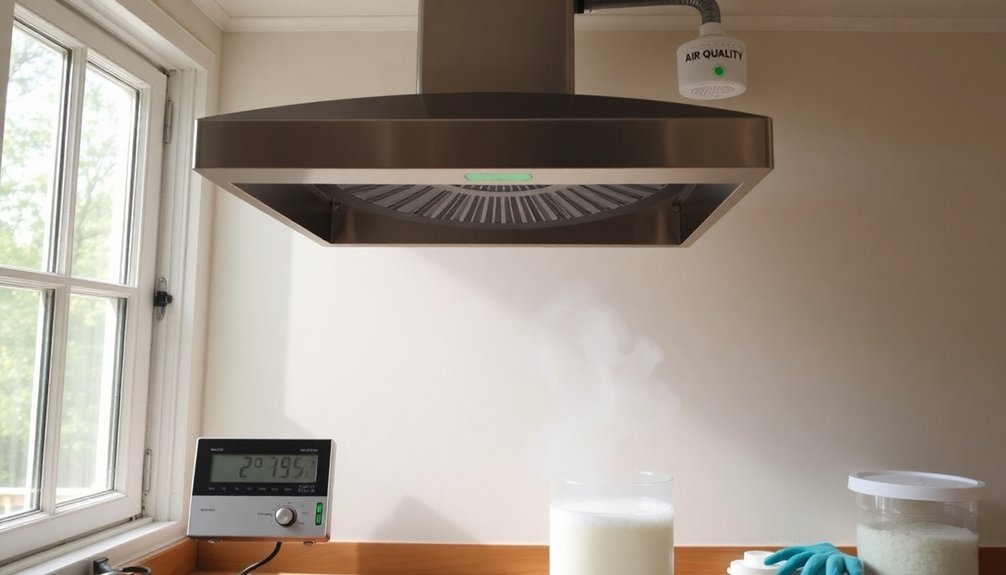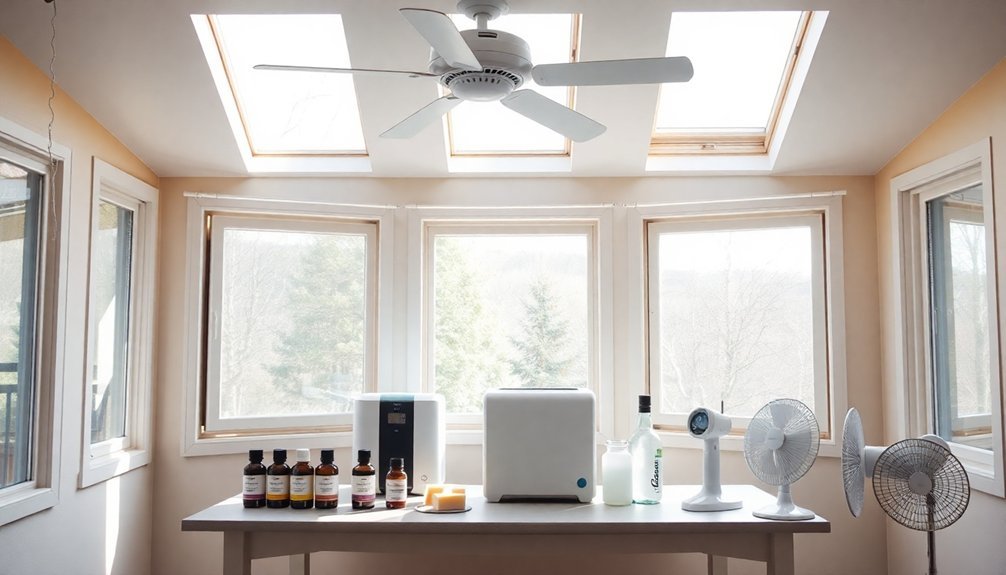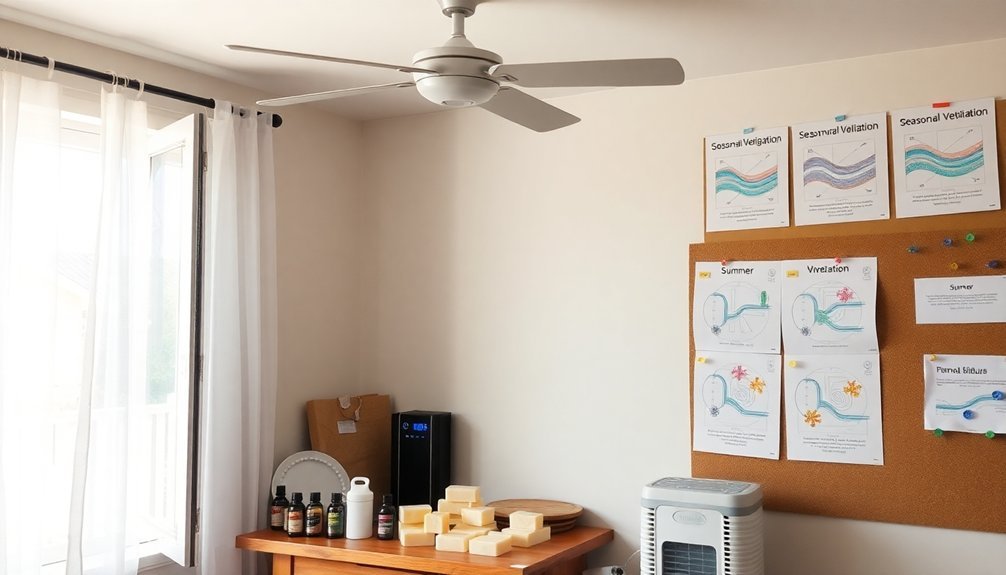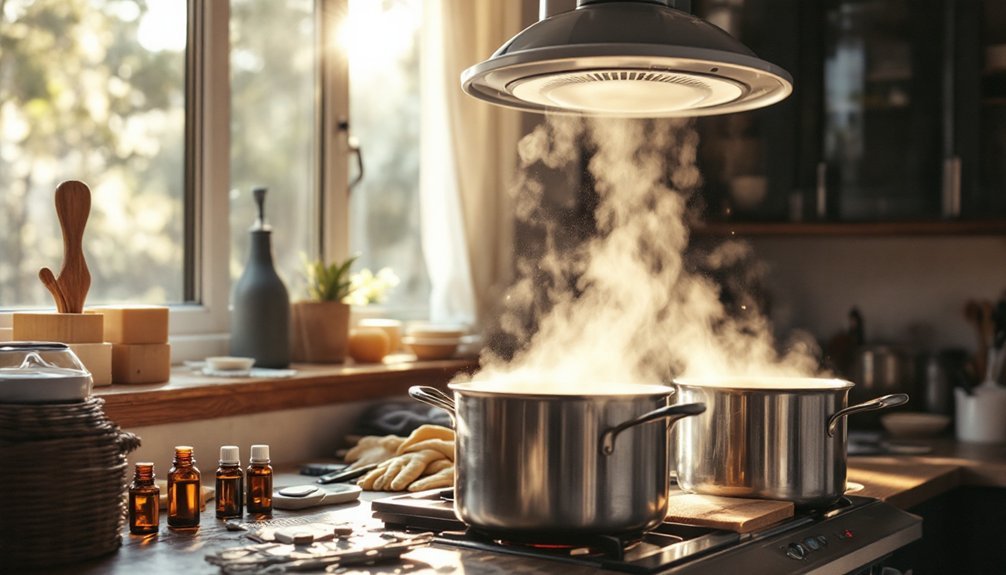When making soap, you'll need proper ventilation to protect yourself from harmful lye fumes. Set up your workspace near windows, use fans to direct vapors away from your breathing zone, and consider a respirator when handling lye. For larger batches, invest in fume extractors or air purifiers to remove caustic particles. Don't forget ventilation during the curing process too. Effective airflow strategies change with seasons, ensuring both your safety and quality soap production.
Understanding Lye Fumes and Their Health Impacts

When making handmade soap, you'll inevitably encounter lye, a caustic substance that creates fumes when mixed with water.
These fumes can cause respiratory irritation if inhaled, leading to coughing and discomfort in your breathing passages. Proper safety gear includes wearing surgical masks when handling lye to prevent inhalation of harmful vapors.
The risks increase considerably in enclosed spaces without proper airflow. While brief exposure typically causes only temporary irritation, prolonged or repeated exposure may lead to more serious respiratory issues.
That's why understanding these risks is essential before you begin your soap making journey.
Don't let this discourage you—with proper precautions, soap making is a safe craft.
The key is managing these fumes through proper ventilation techniques, which not only protects your health but also creates a more comfortable creative environment.
Essential Ventilation Equipment for Home Soap Making
Four key pieces of equipment form the foundation of a safe soap making ventilation setup.
Respirators protect your lungs from lye fumes and should always be worn when handling caustic materials.
Fume extractors actively remove caustic particles from the air, enhancing your overall safety.
Air purifiers help cleanse the workspace of VOCs and particulates, though they shouldn't be your only defense.
Fans and exhaust systems circulate and extract contaminated air, greatly reducing fume concentration. Larger batches of soap produce more dangerous vapors, requiring enhanced ventilation solutions.
If you're working in a small space with limited ventilation options, consider mixing lye outdoors or using makeshift solutions like strategically positioned fans and open windows.
Remember that proper ventilation isn't just about comfort—it's essential for protecting your respiratory health and reducing exposure risks during the soap making process.
Setting Up Your Workspace for Optimal Air Flow

The foundation of safe soap making begins with strategic workspace design. Position your workstation near windows for natural ventilation and guarantee you have a spacious, open area to prevent fume buildup.
Arrange your windows and doors to create cross-ventilation paths, keeping the space clutter-free for unobstructed airflow.
When setting up your soap making area, prioritize these ventilation essentials:
- Install stainless steel workbenches that allow easy cleaning while positioning them where air can flow freely around your workspace.
- Direct fans strategically to channel fumes away from your breathing zone and toward exit points.
- Organize shelving and storage to keep materials accessible without blocking vital ventilation pathways.
Remember that mixing lye with water creates harmful fumes that can damage your respiratory system if inhaled regularly or in large quantities.
Ventilation Considerations During the Curing Process
Proper ventilation during soap curing isn't merely a minor detail—it's vital for transforming your freshly made soap into a high-quality, long-lasting product.
Place your soaps on their edges in a cool, dry area with good airflow to guarantee even drying on all sides.
You'll need to adapt your setup based on your climate and soap type. Humid environments require dehumidifiers to prevent glycerin from drawing moisture and causing your bars to "sweat."
Position fans strategically to enhance air circulation, especially for cold process soaps which need longer curing times than hot process varieties.
Choose curing racks made of non-reactive materials like stainless steel or wood—never aluminum, which reacts with lye.
Bamboo or cane baskets also work well by allowing airflow around each bar.
Avoid using airtight containers or plastic wrap that can trap moisture and prevent proper airflow, negatively affecting the curing process.
Seasonal Adjustments to Your Soap Making Ventilation

Seasons dramatically alter soap making conditions, requiring thoughtful ventilation adjustments throughout the year.
During summer, you'll need increased air circulation to combat humidity and heat that can affect curing times and product quality.
Winter often demands reduced ventilation to prevent cold drafts while still removing chemical fumes.
Your seasonal strategy should include:
- Spring/Fall: Use moderate ventilation with windows partially open to balance fresh air intake with temperature control.
- Summer: Deploy dehumidifiers alongside fans to maintain ideal drying conditions and prevent excess moisture absorption. Installing split system HVAC units provides efficient temperature control while saving valuable workspace in smaller soap shops.
- Winter: Implement programmable thermostats and targeted exhaust systems to remove fumes without sacrificing heat.
Consider your regional climate when fine-tuning these adjustments, as local weather patterns will greatly impact your ventilation needs.
Frequently Asked Questions
Can I Make Soap in an Apartment With Limited Window Access?
You can make soap in your apartment with limited windows. Use a fan, consider melt-and-pour methods, wear protective gear, and never mix lye in confined spaces. Ventilation kits or portable air purifiers help too.
How Do Ventilation Requirements Differ for Melt-And-Pour Versus Cold Process Soap?
Melt-and-pour soap requires minimal ventilation since it doesn't produce hazardous fumes. You'll need only basic airflow like open windows. Cold process demands robust ventilation systems because lye creates dangerous caustic fumes you must avoid inhaling.
Are Certain Essential Oils More Hazardous, Requiring Additional Ventilation Precautions?
Yes, certain essential oils require extra ventilation. Citrus, eucalyptus, and tea tree oils release stronger VOCs. You'll need better airflow when using these oils to prevent respiratory irritation and headaches during your soap-making process.
Will a Bathroom Exhaust Fan Provide Sufficient Ventilation for Small Batches?
A bathroom exhaust fan can work for small batches, but it's not ideal alone. You'll get better protection by combining it with a respirator and keeping the door closed during lye mixing.
How Long Should Ventilation Continue After Completing the Soap-Making Process?
You should continue ventilation for several hours after soap making. Keep fans running during the curing phase to remove lingering lye fumes and VOCs from essential oils. Don't stop until the air is completely clear.
In Summary
You're now equipped to create soap safely in your home. Remember, proper ventilation isn't optional—it's crucial for protecting your health from lye fumes. With the right equipment, well-designed workspace, and seasonal adjustments, you'll guarantee clean air while crafting beautiful soaps. Don't cut corners on ventilation, and you'll enjoy your soap making hobby without compromising your wellbeing.





Leave a Reply